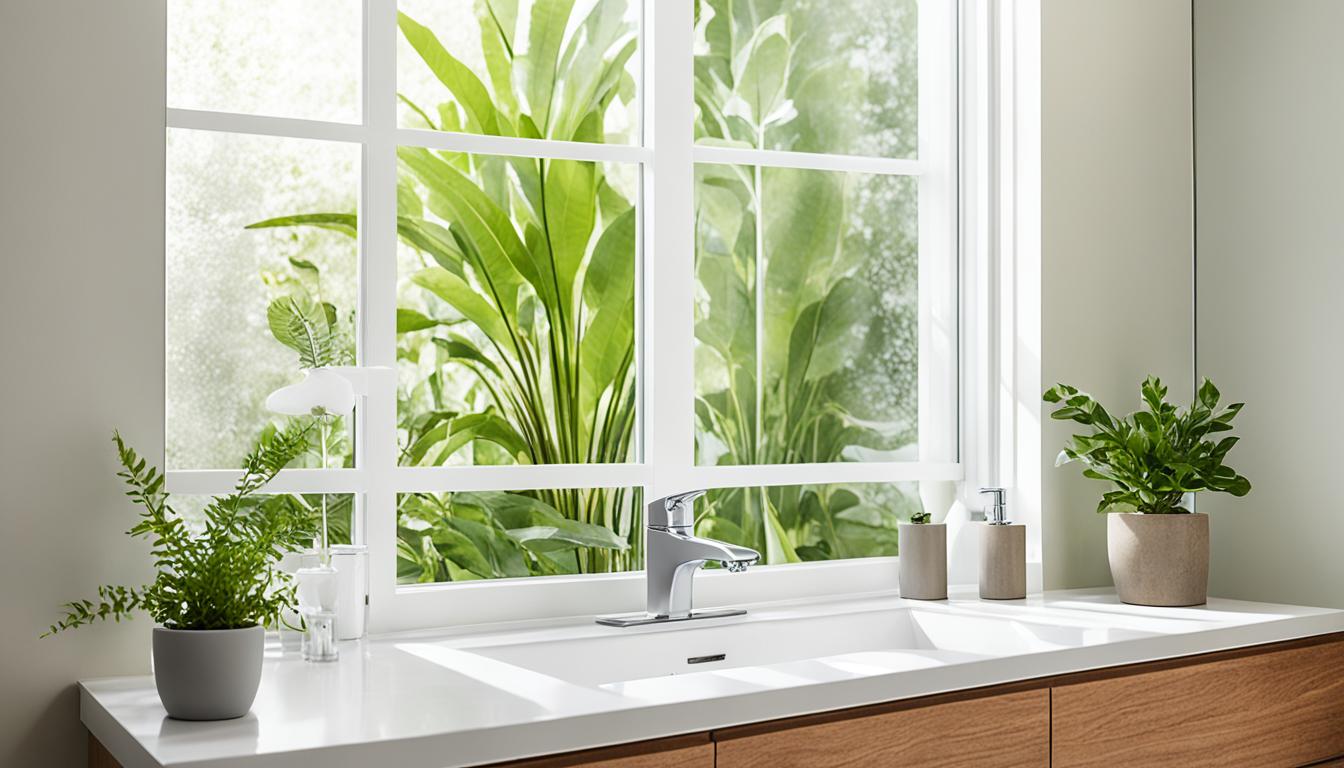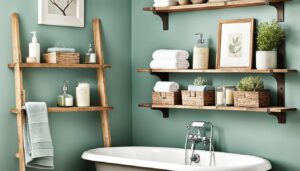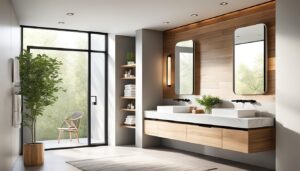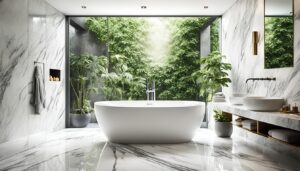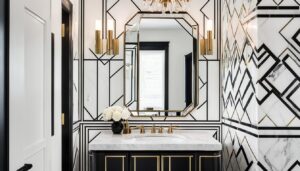Wondering about the water and energy your bathroom wastes? Americans use a lot of water daily, mostly in the bathroom. With erratic rainfall and a push for greener homes, it’s time to check our bathroom habits.
Cutting back on water and energy in the bathroom helps lower bills. Using cooler water settings and unplugging devices when not in use saves a lot. Also, swapping for LEDs, which are cooler and last longer than old bulbs, saves energy. Adding motion sensors or timers, and picking ENERGY STAR® products cuts down on waste.
Key Takeaways
- Americans use 80-100 gallons of water per day, mainly in the bathroom.
- Reducing water use and managing energy consumption are key to decreasing utility costs.
- LED bulbs are more efficient and cooler compared to incandescent bulbs.
- Using motion sensors or timers significantly curbs unnecessary energy expenditure.
- ENERGY STAR® fixtures contribute to an energy-saving bathroom.
The Importance of an Energy-Efficient Bathroom
An energy-efficient bathroom offers numerous advantages beyond saving money each month. Homeowners can help save the planet and cut costs by making their bathrooms more sustainable. This has a lasting impact and offers great benefits.
The Environmental Impact
Creating an energy-efficient bathroom is key to using less resources. Bathrooms use a lot of water and energy. By using low-flow showerheads, dual-flush toilets, and energy-saving water heaters, we can use less water. These changes help the environment by reducing harmful emissions and conserving water.
Financial Benefits
Energy-efficient improvements in your bathroom save you money too. Installing eco-friendly fixtures and lighting can lower your bills. Though they cost a bit at first, you’ll save more on utilities in the long run. Plus, these upgrades raise your home’s value, making it a wise investment.
Incorporating Low-Flow Showerheads
Switching to low-flow showerheads is a smart move for a more efficient bathroom. These showerheads limit the flow to 2.5 gallons per minute or less. This reduction in flow saves both water and energy, lowering costs.
Benefits of Low-Flow Showerheads
There are many gains when you install a water-saving showerhead:
- Water Conservation: Key for places with little water.
- Cost Savings: You’ll see smaller water bills and spend less on energy.
- Environmental Impact: Helps lessen the use of water and energy worldwide.
Tips for Installation
Here are some easy steps for fitting your new low-flow showerhead:
- Remove the Old Showerhead: Twist off carefully to prevent damaging the pipes.
- Clean the Pipe Threads: Brush off any old tape or dirt.
- Apply Plumber’s Tape: Wrap the tape around the pipe threads for a tight seal.
- Screw on the New Showerhead: Start by hand, then tighten with a wrench if needed.
- Check for Leaks: Turn the water on and look for leaks where it connects.
Follow these steps and add a water-saving showerhead to use less water and boost your home’s efficiency.
Switching to LED Lighting
Changing your bathroom lights to LED is a wise move. LED lights use less energy and last longer than traditional bulbs.
Advantages of LED Lighting
LED lights are a top choice for bathrooms for many reasons. Here are the main benefits:
- Energy-efficient lighting: LED lights use much less power, saving on electricity.
- Long-lasting bathroom lights: LEDs have a longer life, so you change them less often.
- Reduced operational heat: They stay cool, making them safer and cutting costs.
Making the switch to LED can really improve your bathroom. It makes it more efficient and nicer to be in.
Choosing the Right Color Temperature
Picking the right LED color is key for your bathroom’s look and feel. LEDs come in warm to cool colors, each with a different purpose:
- Warm light: Gives a cozy vibe, great for evenings.
- Daylight: Mimics natural light, ideal for mornings.
- Cool light: Good for detailed tasks, it’s bright and clear.
Getting the right color LED can improve your bathroom’s beauty and function.
Using LED bulbs means your bathroom is modern and eco-friendly.
Water-Saving Toilets
Water-saving toilets are crucial for green bathrooms. They cut down on water use without losing efficiency.
How High-Efficiency Toilets Work
High-efficiency toilets are special because they use less water to flush away waste. They need only about 1.28 gallons per flush. This is much less than the old 3-gallon toilets. They reach this efficiency with smart design and modern technology. This ensures each flush is strong and effective.
Additional Water-Saving Tips
There are more ways to save water in the bathroom besides efficient toilets:
- Insert a plastic bottle in the toilet tank to reduce flush volume.
- Invest in toilets with fill cycle diverters to optimize water use.
- Fix leaks right away to stop wasting water.
Importance of Energy-Star Appliances
Choosing ENERGY STAR® fixtures for your bathroom helps save energy. These include light fixtures, bathroom fans, and water heaters. They pass strict tests to make sure they save a lot of energy.
When you pick ENERGY STAR® fixtures, you help the environment and save money. These fixtures use less energy. This means they help keep the planet green while working great in your bathroom.
Let’s look at how ENERGY STAR® fixtures are better for efficient bathrooms:
| Feature | Standard Appliances | ENERGY STAR® Appliances |
|---|---|---|
| Energy Consumption | High | Low |
| Lifetime Operating Cost | Costly | Economical |
| Environmental Impact | Adverse | Minimal |
| Performance | Standard | Enhanced |
Adding ENERGY STAR® fixtures to your bathroom is smart. They lower your electric bills. They also help protect the planet for future generations.
Smart Home Automation in the Bathroom
Using home automation in the bathroom boosts energy savings and adds convenience. Today’s intelligent bathroom design leads to eco-friendly and economical homes. Motion sensors and timers are major parts of this improvement.
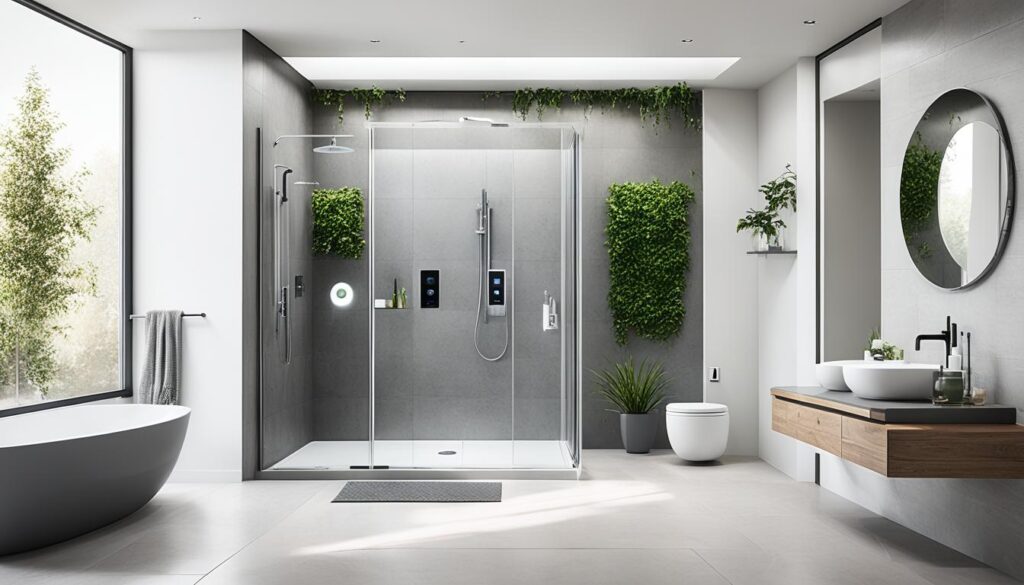
Using Motion Sensors
Motion sensors are key to automating homes. They control lights and exhaust fans based on movement. So, they only work when needed. This energy-saving technology cuts down on electricity waste:
- Lights turn on or off as you enter or leave.
- Exhaust fans react to the amount of humidity or if someone is there.
- You can adjust how sensitive these sensors are and how long they stay on.
Installing Timers
Timers in smart bathrooms set how long gadgets run. They keep devices efficient by limiting use time.
Look at how energy use drops with smart bathrooms versus standard ones:
| Feature | Traditional Setup | Home Automation |
|---|---|---|
| Lighting | Manual switch, risk of being left on | Motion sensors, auto-off |
| Exhaust Fans | Manual operation, often left running | Sensors/timers, auto operation |
| Energy Efficiency | Inconsistent management | Optimized, minimal waste |
Putting these energy-saving technologies into action lowers energy use. Smart home automation in bathrooms brings comfort and helps the planet.
Selecting Green Building Materials
Opting for sustainable materials is key during eco-friendly bathroom updates. Choose materials that are green and last long. This ensures your bathroom will stand the test of time and be kind to the planet.
Look for materials that are low-toxic and gentle on the earth. These choices make your home healthier. Pick sustainably sourced wood, recycled glass tiles, and low-VOC paints for a greener bathroom.
Here’s a comparative table to guide your selection of sustainable materials:
| Material Type | Sustainable Benefits |
|---|---|
| Recycled Glass Tiles | Diversion of waste from landfills, low energy production |
| Sustainably Sourced Wood | Replenishes forests, provides a natural aesthetic |
| Low-VOC Paints | Reduces indoor air pollution, safer for health |
| Bamboo | Rapidly renewable, strong and durable |
Choosing these materials means you’re building a green, eco-friendly bathroom. It shows you care about our planet. Plus, it meets global green building standards, making your home energy-efficient and responsible.
Eco-Friendly Water Heating Solutions
In our journey towards a greener planet, choosing eco-friendly water heating is crucial. Solar power and heat pump technology can lower our carbon footprint. This is key for a healthier earth.
Advantages of Solar Water Heaters
Solar water heaters use the sun’s energy to heat water, making them a great eco-friendly choice. They help us use less fossil fuel and save on energy bills. Plus, they work well all year in sunny places.
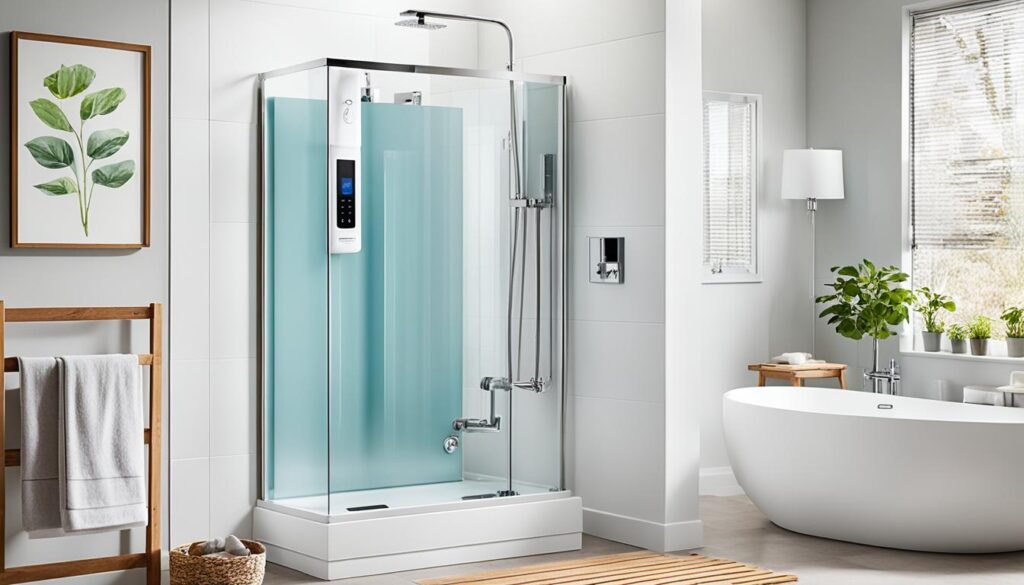
Heat Pump Technology
Heat pump heaters also offer a smart solution. They pull heat from the air or ground to heat water. These units use less electricity than old-school heaters. Thanks to improvements, they are now even more efficient, saving more money.
| Water Heating Method | Energy Source | Efficiency | Cost |
|---|---|---|---|
| Solar Water Heaters | Solar Energy | High | Moderate |
| Heat Pump Heaters | Ambient Heat | Very High | Moderate to High |
By choosing these innovative, energy-saving systems, we gain environmental and financial benefits. They push us towards a sustainable future.
Incorporating Sustainable Design Principles
Sustainable design in the bathroom is more than just decorating. It combines eco-friendly trends with sustainable home decor. This makes sure beauty and utility both save natural resources.
There are several ways to add these sustainable ideas to your bathroom:
- Energy-saving fixtures: Choose low-flow showerheads and faucits for less water use. Add LED lights to cut down on electricity.
- Water conservation strategies: Get high-efficiency toilets and smart water sensors. They reduce water waste and manage how much you use.
- Material selection: Pick recycled or eco-friendly materials like bamboo, reclaimed wood, and natural stones. They’re not just good looking but also good for the planet.
Using these sustainable principles cuts down on energy and water use. It also turns your bathroom into a green, modern space. By doing this, you make your home stylish and eco-friendly. You lead the way in using bathroom designs that protect our planet.
| Design Principle | Implementation | Benefits |
|---|---|---|
| Energy-saving fixtures | Low-flow showerheads, LED lighting | Reduces water and electricity usage |
| Water conservation strategies | High-efficiency toilets, smart sensors | Minimizes water wastage |
| Material selection | Recycled, sustainably sourced materials | Eco-friendly, attractive aesthetics |
Conclusion
Making your bathroom more energy-efficient is smart for the planet and your wallet. Use low-flow showerheads, LED lights, and water-saving toilets to cut down on water and energy use. It’s not just about saving money; it’s about helping our planet.
Sustainability starts with simple choices. Switch to Energy-Star appliances and consider smart home systems. Add eco-friendly water heaters like solar ones or heat pumps. Together, these steps significantly lower your environmental impact.
Every homeowner has the power to make a difference. By choosing these energy-saving options, you’re improving your home and the world. Let’s build bathrooms that show our love for the earth.


